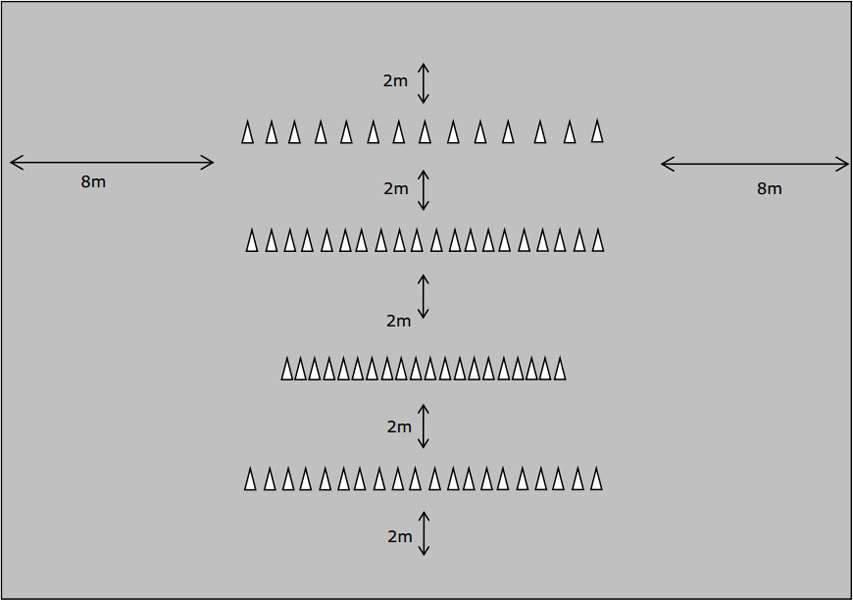Slalom skating for dummies
Understanding a discipline as a spectator is not easy when you don't know the rule basics! In order to solve that problem, there is nothing better than a quick scan. Let's discover the main rules of slalom skating...
Par alfathor

Slalom skating has several types of subdisciplines
The competition formats have evolved through time and according to influences. Today slalom skating has three competitions: one of speed and two of style (classic and battle).
Speed slalom
Speed slalom is probably the best known and the oldest slalom discipline. Let’s remember the quad skaters slaloming down the hills of the Trocadéro in Paris in the 80’s – 90’s. But the discipline is even older than that.
In competition, the course is made of a line of 20 cones placed 80 cm apart, preceded by a run-up area (see figure below). The aim is to cover the distance as fast as possible (12 m of run-up and 16 m of cones) in slaloming along the line. Each non-slalomed cone (kicked, moved or avoided) leads to a +0.2 sec penalty. Over four non-slalomed cones, the run is void.
Note: Still a few years ago the way you slalomed the line didn’t matter. You could skate forward, backward, with one or two feet. Yet, once the line started you could not change techniques along the way. The most common technique is frontward one foot, however very fast skaters have also made the difference with the backward one foot technique. Now, the international WSSA rules only accept the most widely used technique, frontward one foot, out of concern for standardization and accuracy of judging.
The speed slalom competition has two phases: the Qualifications and the KO Systems.
During the qualifying phases, you have do the best possible time compared to your opponents. You have two timed tries, most of the time with a free start. The best of your two tries is used to make a qualification ranking on which the judges will rely to organize the groups of the final phases.
In case of a tie, the decision is taken according to the second times of the concerned skaters. In case of a tie again, the skaters are given an extra try.
During the final phases, the victory is played with KO Systems: the skaters fight in duels. You should win two runs in order to win the duel. You have to be faster than your opponent, and be clean in order to avoid time penalties. The duel groups are organized according to the qualification ranking, and the advantage is given to the best ranked skaters: the first meets the last, the second best meets the second last, and so on. Each winner is qualified for the next round, until the ultimate round: the final.

Classic Freestyle Slalom
Classic Freestyle (formerly figure or style slalom) is a competition that could be compared to that of free program in artistic skating. The contestants have 1 min 30 to show a choreography of their choice with the music of their choice, on three lines of cones with different spacings: 20 cones of 50 cm, 20 cones of 80 cm and 14 cones of 120 cm. They have only one run (try).
The freestyler’s performance is graded according to technical criteria (60% of the grade) and to artistic criteria (40% of the grade). Are taken into account the variety and the technical difficulty of the tricks and combos performed, the quality of the footwork and links, the speed and rhythm, as well as the music and body expression. Falls, losses of balance and kicked/moved cones are penalized.
The contestants are ranked according to a relative ranking. The place of a skater corresponds to the average place given by the judges. Points are only taken heed of in case of a tie.
In case of a tie:
- The skater placed in front by the majority of the judges gets the advantage
- The skater getting the more points after the sum of the judges’ grades gets the advantage

Battle Freestyle Slalom
Battle Freestyle is the most established format in the world. Battle saw the light in the mid-2000’s and was set up by the World Slalom Series. It favors the technical and tactical qualities of the competitors, whereas Classic Slalom gives advantage to creative and expressive qualities. Battle is a competition by direct confrontation, the skaters being gathered in groups of 3 or 4. They are not graded, but judged by direct comparison between the skaters of a same group. Each skater has 2 to 3 runs of 30 sec to technically outbid their opponents. The two best skaters of the group are qualified for the next round.
- 2 runs until the Quarter Finals
- 3 runs for the Semi Finals
- 2 runs and 1 Last Trick in Consolation Final
- 3 runs and 1 Last Trick in Final

The competition area is similar to the Classic area, with one more 10-cone 80 cm line:
- 20 x 50 cm
- 20 x 80 cm
- 14 x 120 cm
- 10 x 80 cm
The judges may ask for a Best Trick in order to decide between skaters: you have to do a single trick or a combo made of tricks of the same family. For the concerned skaters, the judges’ decision will be then based on that unique trick/combo only, disregarding their other runs.
In Final (and in Consolation Final), the Last Trick is a supplementary try to do an ultimate trick or combo. It is added to the other runs of the group’s skaters for the judges’ decision.
Links
Translation: Chloé Seyres
Pictures: FFRS

